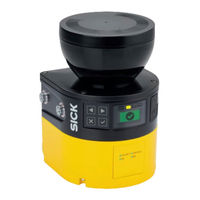SICK microScan3 Pro I/O-EFI-pro Manuals
Manuals and User Guides for SICK microScan3 Pro I/O-EFI-pro. We have 1 SICK microScan3 Pro I/O-EFI-pro manual available for free PDF download: Operating Instructions Manual
SICK microScan3 Pro I/O-EFI-pro Operating Instructions Manual (228 pages)
Safety laser scanners
Table of Contents
Advertisement
Advertisement
